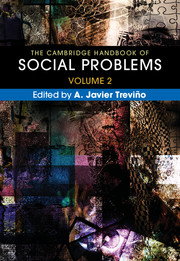Book contents
- The Cambridge Handbook of Social Problems
- The Cambridge Handbook of Social Problems
- Copyright page
- Contents
- About the Contributors
- Introduction
- Part I Problems Related to Health, Safety, and Security
- Part II Problems Related to Crime and Violence
- Part III Problems of Global Impact
- Chapter 27 Urbanism and Urbanization
- Chapter 28 Technology and Social Problems
- Chapter 29 Population and Contemporary Social Problems
- Chapter 30 Environmental Problems
- Index
- References
Chapter 28 - Technology and Social Problems
from Part III - Problems of Global Impact
Published online by Cambridge University Press: 16 March 2018
- The Cambridge Handbook of Social Problems
- The Cambridge Handbook of Social Problems
- Copyright page
- Contents
- About the Contributors
- Introduction
- Part I Problems Related to Health, Safety, and Security
- Part II Problems Related to Crime and Violence
- Part III Problems of Global Impact
- Chapter 27 Urbanism and Urbanization
- Chapter 28 Technology and Social Problems
- Chapter 29 Population and Contemporary Social Problems
- Chapter 30 Environmental Problems
- Index
- References
Summary
Many social problems have important technological aspects. At the same time, it is usually impossible to identify a single, purely technological cause for the problem, nor is it in most cases possible to identify a single technological solution. In practice, such problems can best be understood by conceptualizing the social and the technical as mutually constitutive. It then follows that specific technologies can help reproduce and exacerbate social inequalities, and that unjust social relations can be conducive to the emergence of “bad” technologies. Social exclusion, offshoring, and humankind's proliferating ecological footprint are exemplary problems that have significant social as well as technological aspects. In addition, it is important to realize that technological change in general comes together with social change, and that these at a deeper level correlate with changing moralities, epistemologies, and ontologies. By consequence, technological societies are highly dynamic and reflexive, and the ensuing complexity might itself become socially problematic.
- Type
- Chapter
- Information
- The Cambridge Handbook of Social Problems , pp. 489 - 502Publisher: Cambridge University PressPrint publication year: 2018



